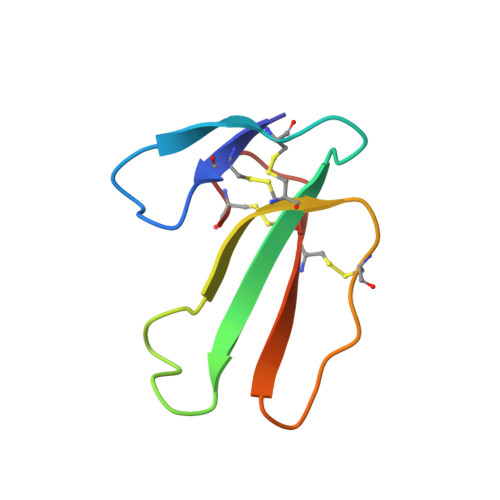Interaction of three-finger toxins with phospholipid membranes: comparison of S- and P-type cytotoxins.
Dubovskii, P.V., Lesovoy, D.M., Dubinnyi, M.A., Konshina, A.G., Utkin, Y.N., Efremov, R.G., Arseniev, A.S.(2005) Biochem J 387: 807-815
- PubMed: 15584897
- DOI: https://doi.org/10.1042/BJ20041814
- Primary Citation of Related Structures:
1RL5, 1ZAD - PubMed Abstract:
The CTs (cytotoxins) I and II are positively charged three-finger folded proteins from venom of Naja oxiana (the Central Asian cobra). They belong to S- and P-type respectively based on Ser-28 and Pro-30 residues within a putative phospholipid bilayer binding site. Previously, we investigated the interaction of CTII with multilamellar liposomes of dipalmitoylphosphatidylglycerol by wide-line (31)P-NMR spectroscopy. To compare interactions of these proteins with phospholipids, we investigated the interaction of CTI with the multilamellar liposomes of dipalmitoylphosphatidylglycerol analogously. The effect of CTI on the chemical shielding anisotropy and deformation of the liposomes in the magnetic field was determined at different temperatures and lipid/protein ratios. It was found that both the proteins do not affect lipid organization in the gel state. In the liquid crystalline state of the bilayer they disturb lipid packing. To get insight into the interactions of the toxins with membranes, Monte Carlo simulations of CTI and CTII in the presence of the bilayer membrane were performed. It was found that both the toxins penetrate into the bilayer with the tips of all the three loops. However, the free-energy gain on membrane insertion of CTI is smaller (by approximately 7 kcal/mol; 1 kcal identical with 4.184 kJ) when compared with CTII, because of the lower hydrophobicity of the membrane-binding site of CTI. These results clearly demonstrate that the P-type cytotoxins interact with membranes stronger than those of the S-type, although the mode of the membrane insertion is similar for both the types.
- Shemyakin and Ovchinnikov Institute of Bioorganic Chemistry, Russian Academy of Sciences, 16/10 Miklukho-Maklaya str., V-437, Moscow 117997, Russia.
Organizational Affiliation:
















